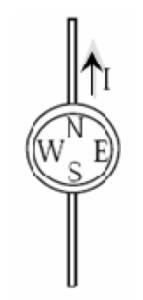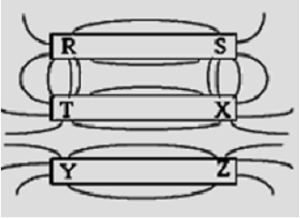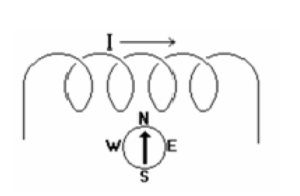Question

A long straight wire conductor is placed below a compass as shown in the top view figure. When a large conventional current flows in the conductor as shown, the N pole of the compass:
A) has its polarity reversed B) points to the south
C) points to the west D) points to the east
▶️Answer/Explanation
Ans:A
Solution: The compass is ABOVE the wire. Using RHRcurl on the wire, the B field points towards the right at the location above the wire. Since compasses follow B field lines, the compass will also point right, which is east.
Question
If a permanent magnet is cut in half halfway between its north and south poles, you will then have
(A) a north pole piece strongly attracted to the south pole piece
(B) two pieces of magnetic material with no overall poles
(C) two smaller magnets, each with its own north and south poles
(D) the north pole piece slightly positive and the south pole piece slightly negative
▶️Answer/Explanation
Ans:
(C)
At the break point, a new north pole and a new south pole will be found such that each smaller piece will have its own north and south poles. The two poles of a magnet can never be isolated.
Question

The diagram to the right depicts iron filings sprinkled around three permanent magnets. Pole R is the same pole as
A) T and Y
B) T and Z
C) X and Y
D) X and Z
▶️Answer/Explanation
Ans:C
Solution: Assume R is north. Based on the lines, T would have to be north and so would Y. This makes X and Z south and S north.
Question

A compass is placed near a coil of wire. A conventional electrical current is then run through the coil from left to right as shown. This will cause the North pole of the compass to:
A) point toward the left
B) point toward the right
C) point toward the bottom of the paper
D) not move since the magnetic field of the coil is into the paper
▶️Answer/Explanation
Ans:A
Solution: A coil of wire (solenoid) like this becomes an electromagnet when the current runs through it. Use the RHR–solenoid to determine that the right side of this electromagnet becomes the north side. Now pretend that the electromagnet is simply a regular magnet with a N pole on the right and a S pole on the left and draw the field lines. In doing so, the lines end up pointing to the left at the location of the compass. Since compasses follow magnetic field lines, the compass will also point left.
